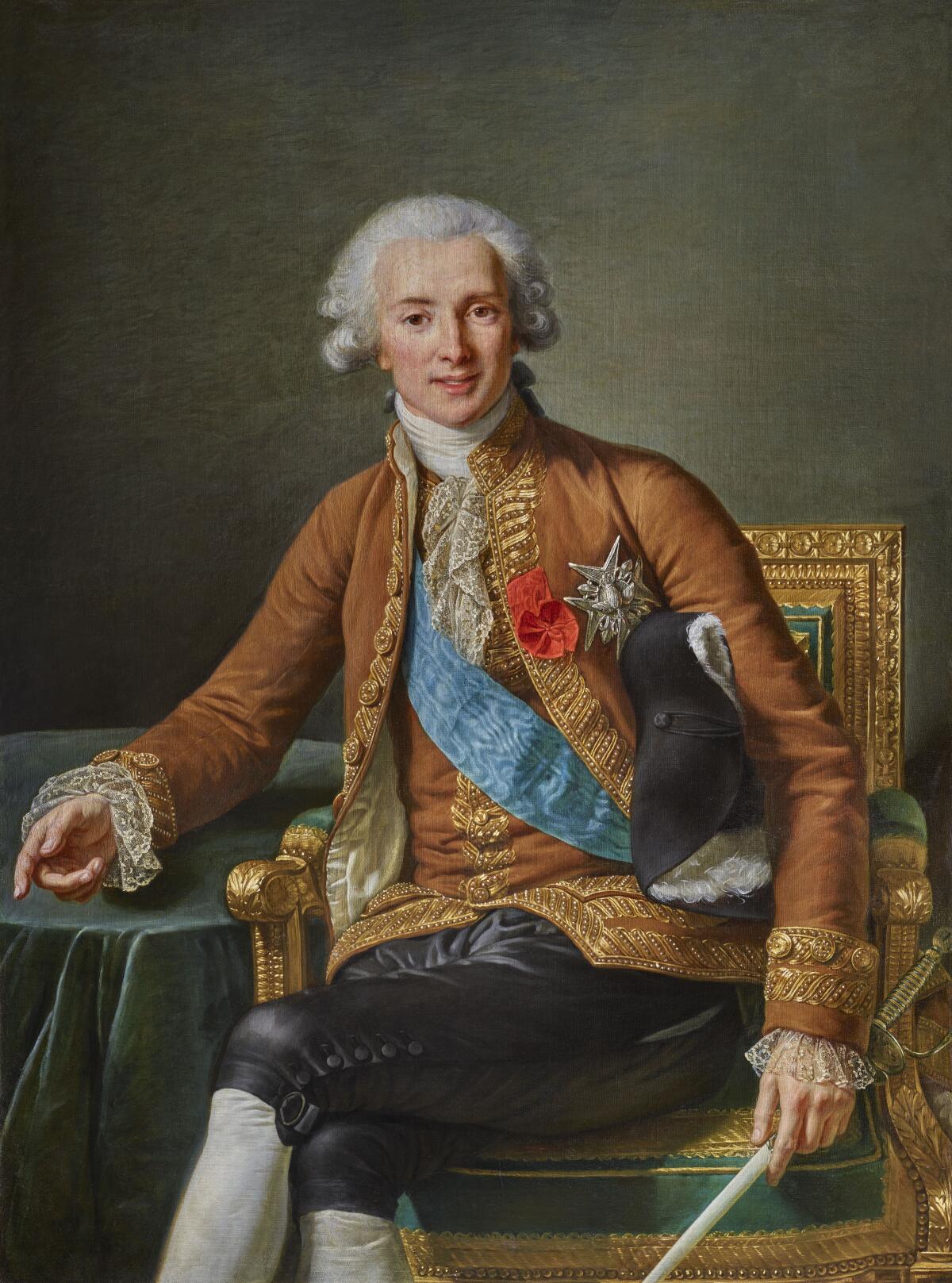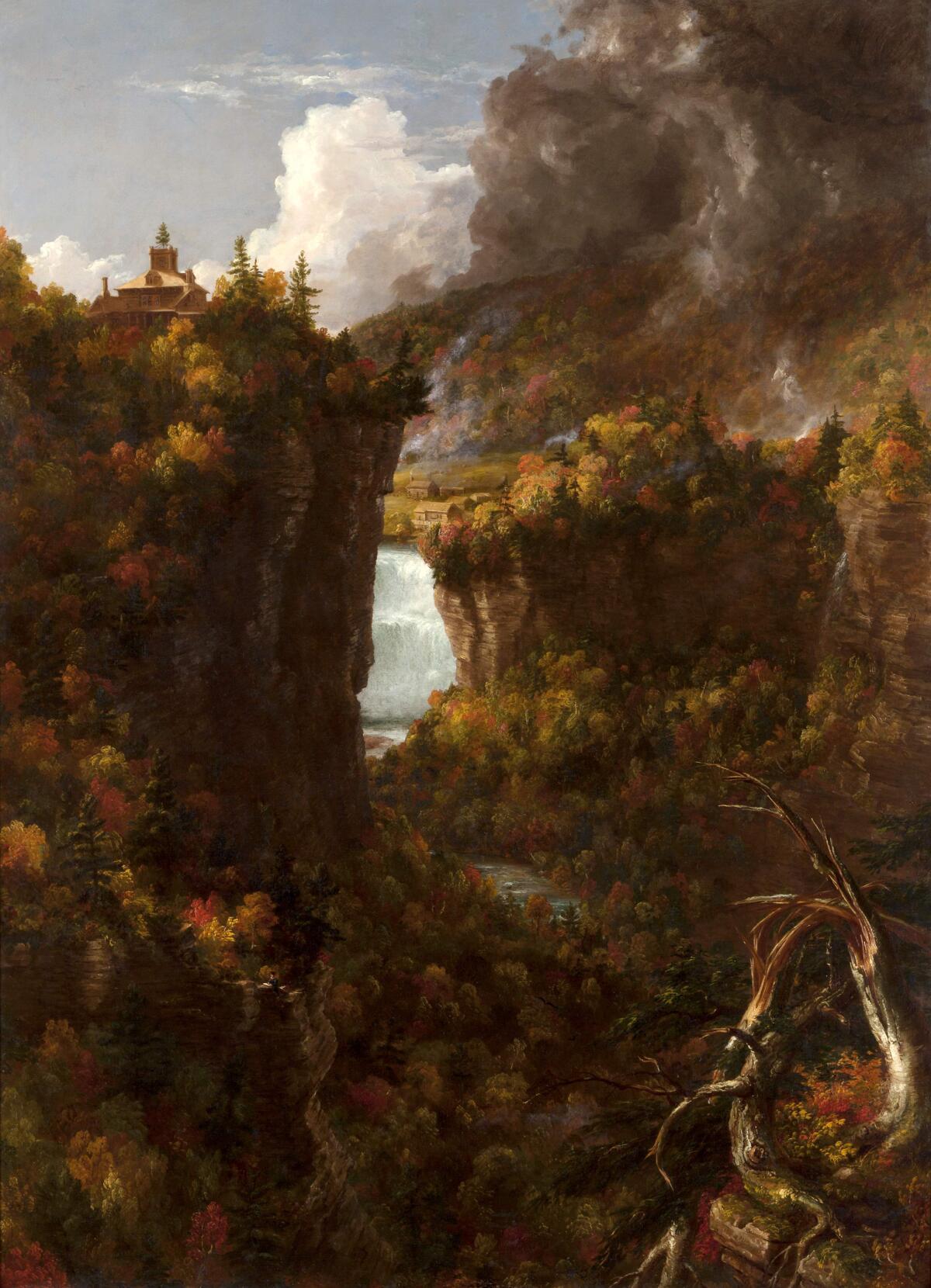Huntington museum lands a smashing gift, painted by court artist to Marie Antoinette

- Share via
The Ahmanson Foundation has acquired its first major European painting for the Huntington Library, Art Museum, and Botanical Gardens, a year after unveiling a new formal relationship to help build the San Marino museum’s permanent collection.
Slightly less than life-size, the seated portrait was painted around 1784 by Élisabeth Louise Vigée Le Brun (1755-1842). Her resplendent picture of Joseph Hyacinthe François-de-Paule de Rigaud, comte de Vaudreuil, age 44, amply demonstrates why she was a leading French artist, court painter to Queen Marie Antoinette and, with Swiss artist Angelika Kauffmann one of the two most important women wielding a paintbrush in 18th century Europe. Vigée Le Brun was at the peak of her powers in the years leading to the French Revolution.
Lavish hardly begins to describe the painting. It’s a knockout.
The attractive young count is seated in a gilded chair, upholstered in emerald-green velvet and designed by Georges Jacob, the great furniture maker who outfitted much of Versailles and Carlton House, the London residence of King George IV. He’s dressed in a brown suede jacket and vest, lined in white silk, trimmed in gold braid and dotted with gold buttons. What appears to be fine Chantilly lace emerges at the throat and cuffs, and he sports black satin breeches and white silk stockings. A black cocked hat trimmed with white ostrich feathers is tucked under an arm.
Whether that’s a white-powdered wig, a fashion accessory on the way out near century’s end, or white-powdered natural hair, on the way in, is hard to say. From the convincing naturalism, I’d guess the latter.
A sash of bright blue watered silk slashes across his chest beneath a flashy silver medallion and a red satin rosette, while a ceremonial sword hangs loosely in his left hand. All of these over-the-top details commemorate his selection by Louis XVI as one of his 100 Knights of the Order of the Holy Spirit, the kingdom’s highest aristocratic honor.
The count was rich. Very. Much of his vast wealth was built from the sweat of forced free labor provided by hundreds of enslaved people working the family’s Caribbean sugar plantations in Saint-Domingue, where he was born, in what is now Haiti. His paternal grandfather was colonial governor of New France, which stretched from Canada through Louisiana to the sea. Vaudreuil was sometimes referred to as creole, but in Paris, the term was likely applied to his place of origin, not to a mixed-race heritage.
One look at the extravagant painting and you can practically see the revolutionary storm gathering in the air. An astronomical wealth gap is virtually pictured. By the time the guillotine began to fall eight years on, both Vigée Le Brun and the count of Vaudreuil had fled France.
What’s truly extraordinary about the painting, though, is its startling sense of animation, which goes far beyond mere descriptive acuity. The great man prepares to speak.

He’s looking you in the eye as his soft mouth begins to open — a popular Baroque technique. Vaudreuil’s right arm is just lifting off the table, covered in a gray-green velvet cloth, as if gearing up to underline his about-to-be spoken point. There, his jacket pulls away from his body in a gentle curve, a shape matching and visually propelling the opening palm of his adjacent hand.
Bodily distortions slowly emerge. Vaudreuil’s left side, closest to us, is slightly larger than his right, from his eyes to his elongated arm holding the sword. The difference launches a subtle visual illusion of torqued movement in space. Vigée Le Brun couldn’t study male anatomy from the nude, due to absurdly prim social restrictions of the day. But given her obvious talents, these bodily alterations seem intentional — more like those that Neoclassical painter Jean-Auguste-Dominique Ingres would later employ for expressive purposes. The spectacle that is Vaudreuil is humanized — brought down to earth.
Most female artists before the 19th century were the daughters of artists. Vigée Le Brun’s father was a pastelist, though not an especially successful one. His daughter was supporting the family by the time she was 15. She wasn’t yet 30 when she painted the comte de Vaudreuil, who some say was her lover, and she had already been elected to France’s royal academy — a rarity for a woman at any age.
To my eye the painting, which I saw recently in a Huntington storage space, is in superb condition. It looks remarkably fresh. Museum Director Christina Nielsen, who identified the potential acquisition last spring, says a light cleaning is all that was required.
The artist kept the painting, one of four copies she made, in the main drawing room of her house on a fashionable stretch of Rue Saint-Lazare. (The only other known copy, which once belonged to the sitter, has been in the collection of the Virginia Museum of Fine Arts for more than 70 years.) After her death, it passed to her niece and then briefly to the family of a Napoleonic diplomat, Charles-Maurice de Talleyrand-Périgord. A noble family bought it in 1847 and had it ever since — until now. It sold to a dealer for almost 600,000 euros at a Paris auction in May.
What the Ahmanson paid has not been disclosed. The foundation was the leading patron of the Los Angeles County Museum of Art’s European art department since the museum’s founding more than half a century ago but severed that relationship in 2020. (The collection can’t boast having a Vigée Le Brun, although LACMA life trustee and collector Lynda Resnick has one of her Marie Antoinette portraits.) Tensions had been rising for years over plans for the museum’s new building, currently under construction. Although well over $130 million in paintings and sculptures gifted by the Ahmanson Foundation were selected by LACMA curators, the museum will no longer present permanent displays of the most important art in its large collection.
The Huntington will, thanks to a firm, five-year renewable contract with Ahmanson. (Once bitten, twice shy.) The foundation has supported various Huntington activities for decades, but buying major art was not on the docket before now.
For the first time, see the inspiration for a Picasso masterpiece in Pasadena and some truly extraordinary paper works in L.A.
Adding an important French painting might seem odd for a museum closely identified with 18th century British art. In reality, it represents a widening sphere of connections. Last year, Ahmanson’s inaugural acquisition was the sensational “Portage Falls on the Genesee,” (circa 1839), a terrific monumental landscape by Thomas Cole — an American artist born in England — installing it in the American galleries.
By mid-November the great Vigée Le Brun will be installed at the end of the Huntington mansion’s entry hall, just to the right of the door leading into the paneled library. Many French decorative arts are in the collection, including nearby tapestries designed by French Rococo painter François Boucher. Vigée Le Brun’s crisp portrait is a first-rate French intersection with the looser, more painterly British Grand Manner portraits for which the museum is famous — Gainsborough’s “Blue Boy” and friends.
The painting is an excellent fit. LACMA’s loss and the Huntington’s gain mount up.
More to Read
The biggest entertainment stories
Get our big stories about Hollywood, film, television, music, arts, culture and more right in your inbox as soon as they publish.
You may occasionally receive promotional content from the Los Angeles Times.












